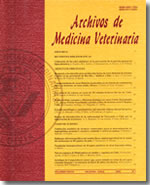Evaluation of postoperative analgesic effect of intraoperative infusions of tramadol and tramadol/lidocaine/ketamine compared with morphine/lidocaine/ketamine in female dogs undergoing ovariohysterectomy
Main Article Content
Abstract
The goal of this study was to evaluate and compare the post-operative analgesic efficacy of intra operative infusions of tramadol and tramadol/lidocaine/ketamine compared to morphine/lidocaine/ketamine in female canines undergoing ovariohysterectomy. 30 female canines were used, without breed distinction with an average age between 1 and 10 years and weight between 2.5 y 37 kgs, creating 3 randomly allocated groups of 10 animals each: tramadol group, tramadol/lidocaine/ketamine group and morphine/lidocaine/ketamine group. All the animals were anesthetized using a standard technique and maintained with inhaled anesthetics, the surgical procedure was performed by the same trained surgeon. The postoperative analgesic effect was determined using the Melbourne Pain Scale, starting 30 minutes after endotracheal extubation, and every 30 minutes after that for a total data collection of 6 hours. The statistical analysis was performed with a Kruskal-Wallis test for non-parametric data. The results obtained noted that the pain scores from the tramadol group showed significant difference (P < 0.05) at times 0.5, 1.5, 2, 4, y 5 hours evidencing an increase in the pain scores when compared to the morphine/lidocaine/ketamine group. The present study concluded that the association of multiple analgesics as a constant infusion provides a superior analgesic effect that the single use of an single infusion of tramadol in females canines undergoing ovariohysterectomy.

